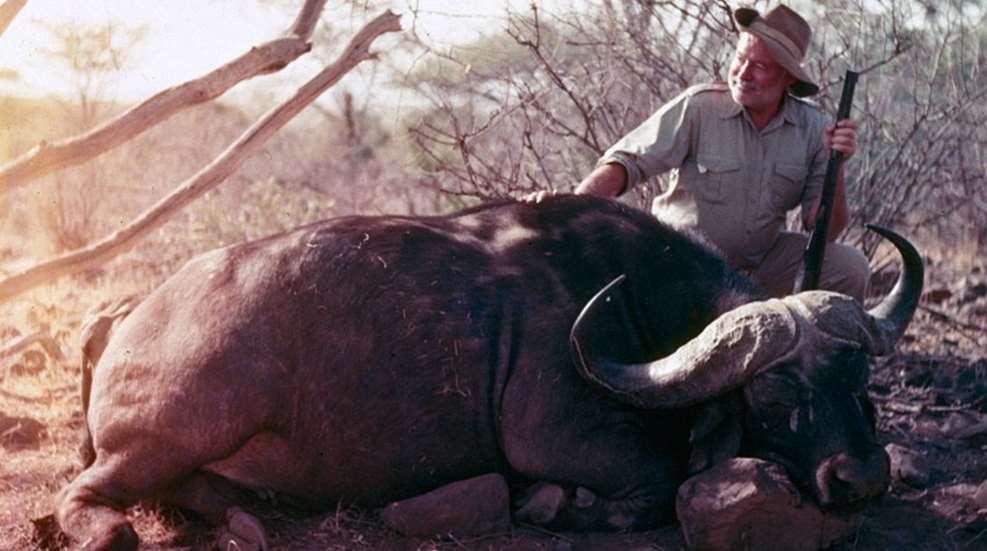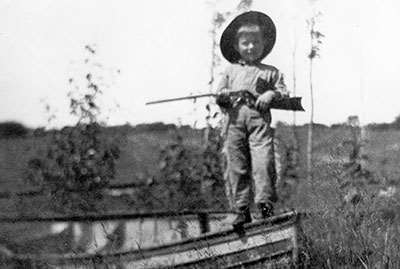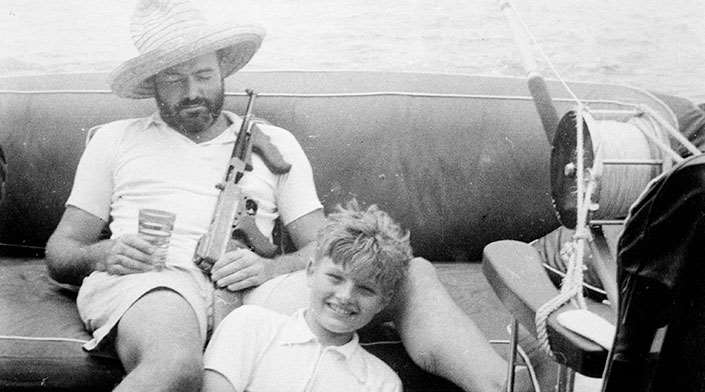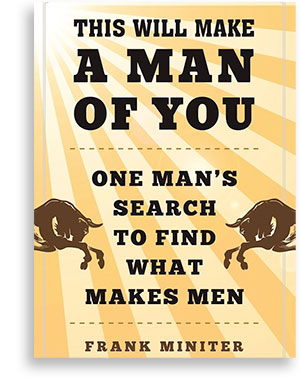
Ernest Hemingway on his second safari in 1953-54 with a heavy Cape buffalo and his Westley Richards double .577 Nitro Express rifle. A rifle he said “could break my shoulder but probably only the collarbone. But it would break the old bull’s shoulder.”
Photos from the Ernest Hemingway Collection, John F. Kennedy Presidential Library and Museum, Boston
The guns we choose say a lot about us. How we handle them does as well. When they are shot, they speak; what they say, good or bad, depends on us. And, as we use them, guns humble us, teach us, show our strengths and weaknesses on the range and in the field, and even, in the course of a lifetime, can become part of us.
So it isn’t surprising that the guns Ernest Hemingway owned, adored and often wrote about in his books and private letters are actual, physical keys to understanding all he became. The thing is, I didn’t begin this investigation from the simple perspective of a curious journalist and gun owner who wanted to know more about a favorite author. I wanted something more.
In 2012, I began working on what became my book This Will Make a Man of You. I’d written one book on manliness in 2009, The Ultimate Man’s Survival Guide, and thought I’d never write another book on the subject, as I agree with Hemingway’s elegant conviction that once a subject is taken up by an author it should be left alone—whatever the state of the book might be, it is loose on the world stage and doesn’t need a younger brother to help it along. But that first book was on the skills a man should know, and readers kept telling me they were looking for something more.
I realized there was a completely different book that must be researched and written to counter, with the truth, the ever-growing attacks on men—that is to say, on manliness. I found myself asking: Why are so many in the mainstream media afraid of a gentleman, a man of character and action, a person who understands how to safely and expertly use firearms? And, what makes us into all we can be anyway, as this is something we seem to be losing? I knew that if such questions could be answered, it would be the antidote to the attacks on manliness now so prevalent in our society—and thus would be precisely what those who are attacking manliness fear most. How can an author resist that?
This quest inevitably led to the last century’s often maligned, and also devotedly loved, icon of manliness in all its aspects, Ernest Hemingway. And soon, because as an author I find it best to actively pursue answers, I followed the Hemingway trail from billfish boats, to African safaris, to those storied cafés in Paris, to the streets of Pamplona, Spain, during the running of the bulls.
Now, plenty of wild things happened along the way, and that’s all in the book, but what’s important here is to dissect out a key to understanding Hemingway, and, in the process, ourselves and our future as a nation. This key is something that an often snarky and politically correct segment of mainstream society derides guns.
As you’ll see, Hemingway was fashioned into all he became in part by guns, and how a mature person handles them. That is to say, he was shaped by a lifelong quest for real experiences.
At Age Five, An Air Rifle
Long before “you’ll shoot your eye out, kid” became a famous line in the movie “Christmas Story” (1984), Hemingway began, as so many of us did, with an air rifle. A photo was taken of him at Walloon Lake, Mich., in the summer of 1904 when he was 5 years old. He was holding a break-action Markham King air rifle, an airgun that then sold for around $1. At the time, ads for Markham Co. air rifles boasted, “Every live, healthy boy wants a ‘King’ Air Rifle. It’s boy nature to want a gun; to want to get out in the fields and woods, nearest to nature, and enjoy youthful life to its fullest extent … .” His mother wrote a note on the back of this photo: “Ernest was taught to shoot by Pa when 2½ and when 4 could handle a pistol.”
His mother was proud of her little man and how much practicing with air guns was molding him—this was the same woman who wrote to tell Hemingway that his first novel, The Sun Also Rises, was “one of the filthiest books of the year ... . What is the matter? Have you ceased to be interested in nobility, honor and fineness in life?”

When he was 10 or so, Hemingway’s grandfather gave him a single-shot 20-ga. shotgun. He was also a member of his high school gun club. Another snapshot, this one taken in 1913 when Hemingway was probably 14 years old, shows him with his father’s Winchester Model 1887 lever-action shotgun in one hand and a dead crow in the other. He had become a wingshooter. All of this was normal stuff for an adventurous boy—as it still is now in areas of America where people happily shrug their shoulders at the mainstream. But it is worth acknowledging them here, as we wouldn’t have Hemingway’s prose, which often shows a deep knowledge of firearms and how man uses them, without this experience in his youth.
When Hemingway was 18 years old, he responded to a Red Cross recruitment effort in Kansas City. He signed on to become an ambulance driver in Italy in early 1918. He arrived in Paris as the city was under bombardment from German artillery. By June, he was at the Italian front. While serving in Italy as an ambulance driver he was wounded and decorated. Later, as a middle-aged man, he would find his way as a journalist and a controversial participant in War World II.
That’s an important dash of context, but to focus back on the steel that helped shape Hemingway, we must realize that throughout his life Hemingway bought, sold and gave away many guns. We’ll concentrate here on the ones he was most fond of, the ones that shaped him the most and that said the most about him.
To Hemingway, guns were practical things. He didn’t collect Colt Single Action Armys or fill cabinets with English side-by-sides he wouldn’t hunt and shoot clays with. Also, guns were friends; if they were works of art, too, that was all fine and good, but he preferred quality and function to fads, fancy engravings and status symbols. He was, as ever, after “the authentic life.”
He believed in writing truly about things he knew about. Guns were a part of his life and therefore were a part of his writing. Like the Spanish fighting bulls he also loved, guns were real; they are actual physical things that demand we treat them maturely and with poise in motion, as real consequences come with the pull of a trigger or a step in front of the horns.
This understanding didn’t stop with guns. This was also how he judged people. In a flamboyant example, while in Paris during the 1920s, Hemingway wrote about his contempt for what he called the “weird lot” in a 1922 article titled “American Bohemians in Paris.” He wrote: “The scum of Greenwich Village, New York, has been skimmed off and deposited in large ladlesful on the section of Paris adjacent to the Café Rotunde … . It is a strange-acting and strange-looking breed that crowd the tables of the Café Rotunde. They have all striven so hard for careless individuality of clothing that they have achieved a sort of uniformity of eccentricity.”
Still, even as he mocked the café trash, he was drawn to those among them who weren’t imposters, to those who were really trying to be painters, writers and other things. His friend and later biographer, A.E. Hotchner, reviewed the cast of characters that were Hemingway’s friends—from Gary Cooper to local fishermen in Cuba—and noted that Hemingway preferred people who were boldly being what they seemed. Certainly such a view could and did rub some people—the critics, the fake artists, the posers—the wrong way.
His guns also had to meet this very un-subjective criteria; beautiful wood, perfect fit and finish and all that were lies if the gun didn’t point easily and go bang even when slathered in ice and mud in an Idaho marsh.
His Working Man’s Guns
Some of Hemingway’s most-used guns were Winchester Model 12 pump-action shotguns. The Model 12 is an internal-hammer gun with a tubular magazine. It was popularly called the “Perfect Repeater,” as a broken-in Model 12 could be fired at least as fast as a semi-automatic. The Model 12 was also a shotgun every American sportsman wanted. It wasn’t then particularly cheap, but it was functional, tough and offered multiple shots. Its price tag was the result of its engineering and manufacture, not the result of embellishments. Hemingway’s original Model 12 was made in 1928. It had a 30" barrel with a full choke. He would shoot this gun in Cuba, Idaho and even Africa.
In his short story “Under Kilimanjaro” he wrote: “Ngui had been loading the Winchester 12-gauge pump with SSG which is buckshot in English. We had never shot anything with SSG and I did not want any jams so I tripped the ejector and filled it with No. 8 birdshot cartridges fresh out of the box and filled my pockets with the rest of the cartridges.”
What Hemingway was preparing to do, on his second African safari in 1953-54, was to follow a wounded leopard into the bush. For this chore he chose his Model 12.
In that same story he wrote: “I had the old, well-loved, once burnt up, three times restocked, worn smooth old Winchester Model 12 pump gun that was faster than a snake and was, from thirty-five years of us being together, almost as close a friend and companion with secrets shared and triumphs and disasters not revealed as the other friend a man has all his life.”
The leopard would be found too wounded to put up a fight, but by going in after the leopard with his old friend, a Model 12 American-made shotgun, Hemingway was living his stated conviction that “[i]n the ethics of shooting dangerous game is the premise that the trouble you shoot yourself into you must be prepared to shoot yourself out of.”
Many of Hemingway’s other guns were just as unpretentious. He long used a Browning Superposed, likely a Grade 1 with no engraving. The Browning Superposed was one of the first over-under shotguns ever produced. It introduced innovations such as the single-select trigger to the stackbarrel, and it was considered revolutionary in the 1930s when Hemingway bought and used one. In a letter, Hemingway called it a “cracking good Browning over-under.” The Superposed was the last firearm to be designed by John Browning.
Guns designed by John Browning were a mainstay in Hemingway’s cabinet. This included several Browning Auto-5s. The Browning Automatic 5 is a recoil-operated semi-automatic shotgun, and it was the first hyper-successful semi-automatic shotgun. He also owned Winchester Model 21 side-by-side shotguns, several Merkel over-unders, and others. Another John Browning invention he used throughout his life was the Colt Woodsman .22 pistol. There are photos of him in his youth and in his silver years with Colt Woodsman semi-automatic pistols.
But it was his Griffin & Howe .30-’06 Sprg. sporting rifle that he would carry from Idaho to Africa on adventures that seeped into his prose and that helped shape him as a big-game hunter and outdoorsman.

In his nonfiction book Green Hills of Africa, Hemingway wrote, “M’Cola put the Springfield in my hand and I opened it to make sure it had solids. The rhino was out of sight now but I could see the shaking of the high grass.” He proceeded to shoot the rhino at “all of three hundred” yards with the .30-’06. Any modern hunter today is now cringing at the thought of shooting a rhino with a .30-’06. But he double-lunged the 5,000-lb. animal, and it died shortly thereafter.
His Griffin & Howe had come with a scope, but Hemingway soon removed it. He shot that rhino at 300 or so yards with an iconic American rifle topped with iron sights. He said of the rifle in a letter: “Comes up naturally as pointing your finger … most beautifully made and finished and simple, practical gun I’ve ever seen.”
This was Hemingway’s judgment of men and guns. The best are what they seem, not showy and flamboyant as a cover for a lack of depth, but simply what they should be.
To Hemingway, Guns Exposed Character
Maybe because he had trouble stopping a Cape buffalo at full charge with that .30-’06 Sprg., on his second safari Hemingway would also carry an English Westley Richards double .577 Nitro Express, a cartridge descended from the .577 Black Powder Express. Hemingway’s rifle used the smokeless cartridge that fired a 750-gr. bullet at a muzzle velocity of around 2050 f.p.s. He wrote in “Under Kilimanjaro”: “Shooting prone I knew the .577 could break my shoulder but probably only the collarbone. But it would break the old bull’s shoulder.”
All of this experience led to the creation of characters who struggled with their manliness, and by struggling, defined what Hemingway thought men must do to become all they can—that is, unlike those who now spend their off time in the alternate realities of video games and Hollywood productions, he believed men must face real things in order to grow into manhood.
In Hemingway’s short story “The Short Happy Life of Francis Macomber,” the main character Francis shows “himself, very publicly, to be a coward” when he drops his rifle and runs from a charging lion he’d wounded. His professional hunter, Robert Wilson (played by Gregory Peck in a classic movie), stands his ground and kills the lion.
When they return to camp, Wilson has the quiet confidence of a man who has proven himself and the humility of a man who is so secure he doesn’t need to say so. Francis’ manliness, meanwhile, has a yellow hole shot right through it.
When Francis wants to talk about the cowardice he exhibited when the lion charged, Wilson tells him it is done and should be left in the field. Wilson implies that Francis will have other chances to redeem himself as long as he doesn’t stop trying, as long as he doesn’t let it grow into a defining characteristic. Francis nevertheless pushes for comforting words until he begins to whine. Hemingway tells us that Wilson thinks, but keeps to himself, that he doesn’t understand how American men like Francis “stay little boys so long … . Sometimes all their lives … . The great American boy-men.”
In the end, Francis does redeem his manhood by standing his ground and shooting a charging Cape buffalo. He became one of Hemingway’s heroes who, though tragic, learn to exhibit poise and self-control in action.
The Gun He Took His Life With
After Hemingway took his own life on July 2, 1961, Life magazine reported that he had done so with a “double-barreled shotgun.” Later, reports said the gun was a Boss he had purchased from Abercrombie & Fitch. But the authors of the fine book Hemingway’s Guns, Silvio Calabi, Steve Helsley and Roger Sanger, found evidence that the suicide gun was likely one of Hemingway’s favorite guns, a shotgun made by W. & C. Scott & Son.
Hemingway’s Scott was his pigeon gun, a long-barreled side-by-side that he used in shooting competitions in Cuba and even while on safari in Africa. The Scott was perhaps his favorite. Photos of him with his Scott show him in Torcello, Italy, duck hunting in the fall of 1948. Others show him with the shotgun at the Club des Cazadores in Cuba. One shows him in Cuba in 1952 showing it off as a self-defense gun after his home had been broken into.
Sometime after he took his own life the shotgun was given to a local welder in Idaho to be destroyed. “The stock was smashed and the steel parts cut up with a torch,” the authors write. One of the authors visited the welding shop, which is actually still in business and being run by the grandson of the original proprietor. Amazingly, the welder still had a few pieces of the gun in a matchbox. Sanger saw the remnants and thought, “This is no Boss.” After showing pictures to experts, he determined that it was most likely Hemingway’s beloved W. & C. Scott with which he shot himself.
Whatever the gun was, Hemingway’s violent end wasn’t the result of a mad moment. There was a long, difficult decline best described in A.E. Hotchner’s book Papa Hemingway. To put a nice spin on it, many have said he decided to go out on his own terms.
The author James Michener once wrote: “Hemingway’s whole public life was dedicated to the creation of a legend.” Michener thought that Hemingway knew he had to go out this way, as a decline would mar the persona.
I think it’s nonsensical to sum up a life, and especially the complex madness at the end of it, in such a neat and simple way.
Whatever we think of the end, I think it best to remember that, to Hemingway, guns weren’t just tools or works of art. Guns, to him, were a reflection of those who use them. They become us at our best and maybe our worst. He was always shooting for best.
 The Hemingway Man Today
The Hemingway Man Today
Authored by NRA Publications Field Editor Frank Miniter, This Will Make a Man of You—One Man’s Search for Hemingway and Manhood in a Changing World challenges readers to take a hard look at the true qualities of manhood and how they are acquired in a culture that increasingly rejects traditional rites of passage. Miniter tackles the challenge head-on by taking a page from Hemingway, recreating the pilgrimage to Spain chronicled in the masterwork, The Sun Also Rises. Running with fighting bulls in the streets of Pamplona, Miniter comes to grips with fear and his own mortality, emerging from those risks with a new sense of how genuine manliness combines honor, courage and an appreciation for the divine. “That is why a wise man learns the world isn’t all about him, that there is something greater than himself,” he concludes.
If only more American men could grasp that principle, the culture war that now threatens our firearm and hunting rights would be much less alarming. Available in hardbound print or digital editions from amazon.com.
—John R. Zent, Editorial Director




































